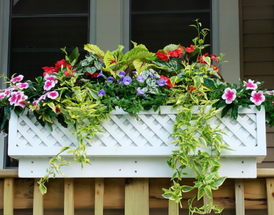Jun 6th 2025
Your Outdoor Space Needs a Mini Meadow – Here’s How to Create One
Imagine a riot of colorful wildflowers, buzzing with bees and flitting with butterflies, right outside your door. Sounds lovely, doesn't it? But what if you don't have a vast garden or even a patch of lawn? The good news is, you don't need acres to enjoy the magic of a meadow. You can create a stunning, vibrant mini meadow right in a container!
Why a Mini Meadow in a Container is a Brilliant Idea
Creating a mini meadow in a container offers a surprising number of benefits, making it an ideal project for gardeners of all levels:
- Space-Saving: This is perhaps the most obvious advantage. Even the smallest balcony, patio, or porch can accommodate a beautiful meadow in a planter, railing planter, or window box.
- Pollinator Paradise: With native wildflower populations declining, providing food and habitat for pollinators like bees, butterflies, and other beneficial insects is more crucial than ever. A mini meadow is a fantastic way to support local ecosystems, even in an urban environment.
- Low Maintenance: Once established, meadow plants are surprisingly resilient and require less coddling than many traditional bedding plants. They're often drought-tolerant and less prone to pests.
- Dynamic Beauty: Unlike static flower arrangements, a mini meadow evolves throughout the season, offering continuous interest as different flowers bloom and fade.
- Eco-Friendly: By choosing native wildflowers, you're promoting biodiversity and creating a natural habitat that aligns with the local environment.
- Stress Relief: There's something incredibly calming and joyful about observing the natural world unfold in your own space. Watching busy bees and colorful butterflies dance among your blooms is a truly delightful experience.
How to Create Your Own Mini Meadow Container: Step-by-Step
Ready to get your hands dirty? Here’s how to cultivate your very own miniature slice of nature:
Step 1: Choose Your Container Wisely
Size matters! For a successful mini meadow, opt for a container that is at least 12-18 inches in diameter and depth. This provides enough space for roots to establish and for a variety of plants to thrive. Deeper is generally better. We recommend PVC, fiberglass, wrought iron, and vinyl containers because of their durability and resistance to rot and insects. Ensuring good drainage is paramount – you don't want soggy roots!
Step 2: Fill with the Right Growing Medium
Don't just use any potting mix. A well-draining, relatively lean soil is best for meadow plants, as they often prefer conditions that aren't overly rich. A good mix would be a combination of loamy garden soil (if available and not too heavy), general-purpose potting mix, and some coarse sand or grit to improve drainage. Avoid mixes with high levels of synthetic fertilizers.
Step 3: Select Your Stars: Flower Recommendations
The key to a successful mini meadow is choosing a mix of flowering plants that will provide continuous bloom from spring through fall and are well-suited to container life. Consider a mix of heights and flower shapes to create visual interest. Prioritize native species for your region to maximize pollinator benefits.
Here are some excellent choices that generally do well in containers:
- For Early Season Color:
- Prairie Smoke (Geumtriflorum): Delicate, nodding reddish-pink flowers.
- Virginia Bluebells (Mertensiavirginica): Bell-shaped blue flowers, emerges early.
- Wild Columbine (Aquilegiacanadensis): Unique, spurred red and yellow flowers.
- For Mid-Season Bloom:
- Purple Coneflower (Echinaceapurpurea): Classic, hardy, and a pollinator magnet.
- Black-Eyed Susan (Rudbeckiahirta): Cheerful yellow petals with a dark center.
- Butterfly Milkweed (Asclepiastuberosa): Essential host plant for Monarch butterflies, vibrant orange flowers.
- Lanceleaf Coreopsis (Coreopsislanceolata): Bright yellow, daisy-like flowers.
- For Late Season Interest:
- New England Aster (Symphyotrichumnovae−angliae): Beautiful purple flowers that extend the season.
- Showy Goldenrod (Solidagospeciosa): A non-aggressive goldenrod with lovely yellow plumes.
You can plant these from seed or purchase small plants from a reputable nursery specializing in native plants. When planting, group species with similar light and water needs together.
Step 4: Plant and Water
If using seeds, follow the packet instructions for depth and spacing. Many native wildflower seeds benefit from a period of cold stratification (check individual seed requirements). If planting nursery starts, gently loosen the roots and plant them at the same depth they were in their original container. Water thoroughly after planting to settle the soil around the roots.
Step 5: Ongoing Care
- Watering: While established meadow plants are drought-tolerant, container plants dry out faster than those in the ground. Water when the top inch or two of soil feels dry. Reduce watering in cooler, wetter weather.
- Sunlight: Most meadow plants thrive in full sun (at least 6 hours of direct sunlight per day).
- Deadheading: While not strictly necessary, removing spent blooms (deadheading) can encourage more flowers.
- Winter Care: In colder climates, consider protecting your container during the winter by moving it to a sheltered location or insulating the pot. Some plants will go dormant and return in spring.
Creating a mini meadow in a container is a rewarding endeavor that brings a slice of natural beauty and vital pollinator support to even the smallest urban dwelling. So, pick out a container, gather your seeds or plants, and get ready to enjoy the enchanting world of your very own mini meadow!




